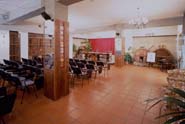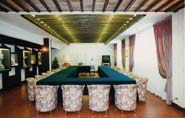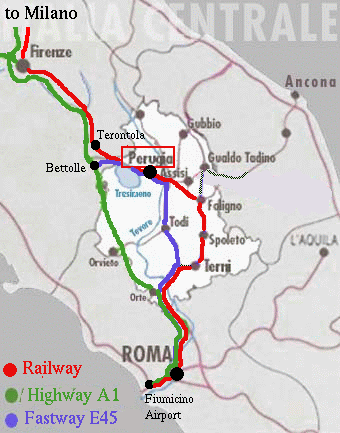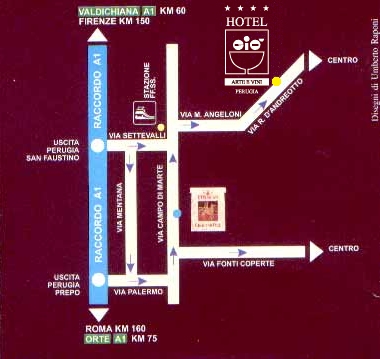
|
S.FI.DE. 2007 |
Statistical Field Theory of Quantum Devices |
|
The Venue
The STATPHYS 23 Satellite Meeting "Statistical
Field Theory of Quantum devices" will take place in Perugia,
Italy, at the Congress Center of Hotel Giņ Arte e Vini. |
![]()
Hotel Giņ Arte e Vini Congress Center
The small but
extremely versatile Congress Center at the
Hotel Giņ Arte e Vini has a
main hall seating up to 130 persons, equipped with higly sophisticated
audiovisual tecnology. Its name, the Sala Cantina, ("Wine Cellar
Hall") is well named as the dessert wines of the hotel's prestigious
Wine Shop are stored there.

 Other characterful meeting rooms complete the main hall. The Sala del Gusto,
with showcases displaying typical products from Umbria, and the Saletta del
Protone, with a door belonging to the nineteenth-century building that once
stood on the site the hotel now occupies.
Other characterful meeting rooms complete the main hall. The Sala del Gusto,
with showcases displaying typical products from Umbria, and the Saletta del
Protone, with a door belonging to the nineteenth-century building that once
stood on the site the hotel now occupies.
The town: Perugia
The History
The capital city of Umbria,
situated some 493 meters above sea level and occupying a surface area of
450 square kilometers, the city of the Griffin – the mythological beast
combining the strength of the lion and the intelligence of the eagle –
has roots grounded in a history going back several thousand years. The
hill on which it rises, overlooking the Tiber river valley between Lake
Trasimeno and Mount Subasio, was already inhabited in the prehistoric
age. The development of the city, founded by the Umbri, dates back to
around the middle of the 6th century BC. Between the 6th and 5th
centuries BC it was settled by the Etruscans who built the innermost
ring of walls around the city and monuments such as the Etruscan Arch,
Porta Marzia, and the Etruscan Well.
Politically, the Etruscan city soon fell under the dominance of Rome
when, in 40 BC, it was conquered after a siege led by the future emperor
Octavian. From then on, Perugia, under the impetus of Octavian himself,
took on renewed vitality and was given the epithet “Augusta.” Upon the
fall of the Roman Empire, Perugia suffered the destruction of the
barbarian invasions and in the attempt to defend the city against Totila
in 547 Bishop Herculan lost his life. Centuries later, in the 11th
century, Perugia was constituted as a free Commune and began to take on
the urban design that distinguishes it even today. The second half of
the 13th century saw the birth of the university, which in 1308 received
from Pope Clement V the title of Studium Generale. During the 14th
century the city was the scene of repeated power struggles between the
major noble families--the Michelotti, the Piccinino, the Fortebraccio,
the Oddi, and the Baglioni--until it finally fell under papal domination,
which lasted until 1860, when the city became part of the unified
Kingdom of Italy. The thousand year history of the city is conserved
almost intact in its city center, beginning with Piazza Grande (now
Piazza 4 November), a superb monumental complex comprising Palazzo dei
Priori, the Cathedral of Saint Lawrence, and the Fontana Maggiore (Great
Fountain), sculpted by the Pisano brothers in the 1200s. Opposite the
piazza, at the other end of Corso Vannuccci, are the famous belvedere
and gardens planted atop the foundations of the Rocca Paolina, the
fortress built by Pope Paul III in 1540 to punish the Perugian noble
families who led the rebellion against Papal rule during the “salt war.”
Not to be overlooked are the museums and libraries (Public and private)
which are all part of a cultural heritage of inestimable value.
Today
The city and its inhabitants enjoy an excellent quality of life. Thanks to a series of new and improved facilities (new parking garages, a network of escalators, a commuter rail system) problems associated with automobile traffic have been greatly reduced. The capital city’s geographic position also makes it quite easy to reach the other cities in the region, “minor” only with respect to their size, as they are all similarly endowed with first class architectural and artistic achievements. During the course of the year, the offerings of cultural events and activities are very rich indeed, featuring an ample program of drama and performing arts in the Morlacchi Theater, and cinemas, bars, pubs and restaurants in the center city and in the suburbs, where a myriad of clubs and cultural associations offer a wide range of events, encounters, concerts, conferences and relaxation. Perugia is also at the center of worldwide attention during major events such as the Sagra Musicale Umbra, Umbria Jazz and the Eurochocolate festival, all of which attract hundreds of thousands of visitors. Finally, there are lots of opportunities for sports fans and amateur athletes to enjoy themselves in parks, gymnasiums, and other recreation facilities.
Getting there
An authentic, historic gateway to the Mediterranean, Perugia is easily reachable from all parts of Europe, by whichever mean you choose to travel.

By plane
The Umbria International Airport (Perugia-San Egidio - tel. +39 075 592 141) has daily flights to and from Milan Malpensa Airport with service provided by Alitalia. Ryan Air offers 3 flights per week from London Stansed and from Frankfurt Hahn (starting June 2007). Seasonal service is also provided to other Italian and european cities. For informations visit: www.airport.umbria.it
By train
The Perugia Fontivegge station has local and intercity service to and from Rome-Termini (circa 2 hours) and Milan (via Bologna-Florence, about 5 hours). For informations visit the official site of the Italian National Railways Company: www.trenitalia.com.
From the train station one can either take a taxi or the bus (Lines 6,7) to reach the Hotel.
By bus
Bus service is provided by SULGA company with
daily connections to and from Rome (Tiburtina train station and Fiumicino airport),
Naples, Florence (twice per week), and Milan (3 times per week). For informations
visit www.sulga.it or call the toll-free number
(if made from an Italian landline) 800 099 061.
SULGA BUS LINES - Perugia
Phone: +39 075 5009641
Fax: +39 075 5053733
Tickets: on board or c/o VISETUR, phone: +39 075 30799
By
car

Driving north from Rome on the A1 Motorway (green on the upper map), take the exit at Orte and follow E45 (blue on the upper map) in the direction of Perugia. Take the Perugia - Florence exit and follow the map on the right.
Driving south from Florence on the A1 Motorway (green on the upper map), take the exit at Valdichiana and follow E45 (blue on the upper map) in the direction of Perugia. Then take one of the suggested exits and follow the map on the right.